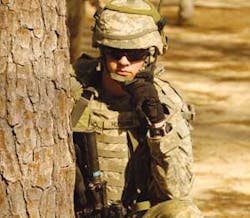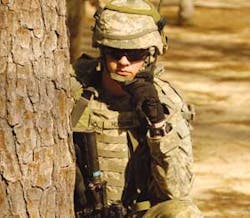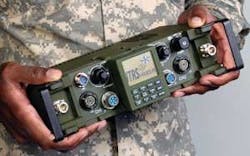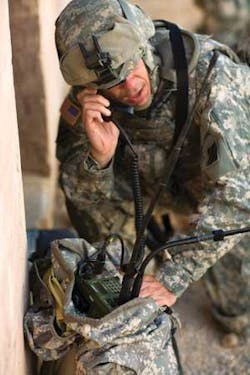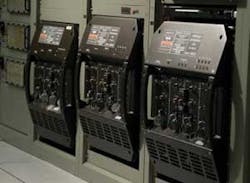Software-defined radio technology, which fuels the U.S. Joint Tactical Radio System program, has become a worldwide phenomenon moving well beyond U.S. military programs. Meanwhile, designers are already looking toward the next game-changing communication technology—cognitive radio.
By John McHale
Whether it is called a disruptive technology or a paradigm shift in communications, the proliferation of software-defined radio (SDR) technology is changing the way the military and other industries view radio communications.
“According to the latest definition agreed upon between the IEEE and the SDR Forum, an SDR is a ‘radio in which some or all of the physical layer functions are software-defined,’” says Manuel Uhm, director of wireless communications at FPGA specialist Xilinx Inc. in San Jose, Calif., and chair, markets committee of the SDR Forum.
Uhm says SDR is well past being the darling of “innovators and technology enthusiasts” and is now embraced by even original skeptics in the U.S. Department of Defense (DOD). Many technologies do not even get past the innovator stage, he adds.
Uhm referred to Geoffrey Moore’s state of technology chart to illustrate his point. In his book Crossing the Chasm: Marketing and Selling High-Tech Goods to Mainstream Customers, Moore broke the acceptance of a technology down among five groups—the first one made up of innovators and technology enthusiasts, and the last represented by “laggards and skeptics,” Uhm says, noting that the DOD Joint Tactical Radio System (JTRS) program is with the laggards and skeptics, and commercial applications are not far behind.
“SDR—based on reconfigurable, reprogrammable semiconductors—will be the basis for most radio electronics, except for the highest volume and low-cost consumer devices, in the next five to seven years,” Uhm says. However, “allowing whatever type of communication you need, wherever you are, and whenever you need it—has yet to be realized by the end user in many markets.”
SDRs are not just radios anymore but “computer platforms with an RF front end,” explains Bryon Tarver, director of engineering for the Communication Networks Division of General Dynamics C4 Systems in Scottsdale, Ariz.
SDR is being developed worldwide, says Rick Spring, manager of business development for software-defined radio at Rockwell Collins in Cedar Rapids, Iowa. The JTRS requirements including the program’s Software Communications Architecture (SCA) have become international standards, he adds. “On the military side, JTRS is the name of game,” Spring says.
“JTRS is SDR,” Tarver says. “All of the radios coming out of JTRS are SDR by design.”
The JTRS program officials plan to replace traditional hardware radios with devices that can emulate any radio’s capabilities by simply changing software. Fielded JTRS radios can be upgraded with software via the wireless information network.
The JTRS programming offices include: the Ground Mobile Radio (GMR); Handheld, Manpack, Small form fit (HMS); Network Enterprise Domain (NED); Airborne, Maritime, and Fixed (AMF); and the Multifunctional Information Distribution System (MIDS). JTRS prime contractors include Boeing, Rockwell Collins, BAE Systems, General Dynamics, Thales, Harris, ViaSAT, Raytheon, and ITT.
JTRS capability
The JTRS radios will become more than radios by transmitting not only voice and data communications but video, too, to give individual warfighters state-of-the-art situational awareness, making them part of a network-centric force, Tarver says.
Tarver’s team at General Dynamics added the Soldier Radio Waveform (SRW 1.0c) to the Rifleman Radio (AN/PRC-154) and the HMS Manpack Radio for vehicles.
The next steps for the Rifleman Radio include security verification testing and final certification, followed by a DOD Milestone C decision, which is the last step before low-rate initial production (LRIP), General Dynamics officials say. The government expects to make its LRIP award for HMS in November 2009.
Under the JTRS program, four suppliers have built and delivered HMS radios to the government for testing and use during military exercises—General Dynamics, BAE systems in Wayne, N.J.; Rockwell Collins; and Thales Communications in Clarksburg, Md. The HMS radios will be the first ones deployed to infantry soldiers, Tarver says.
SDRs are computing platforms, Tarver says. The radios will have the capability to receive real-time intelligence from unmanned aerial vehicles (UAVs), perform blue force tracking through its built-in global positioning system (GPS), and then through data fusion provide a realistic view of the battlespace, he continues.
Still, only the commanders will have capability on their Rifleman radios, not individual warfighters, Tarver notes. The commander will know all of their locations due to the GPS capability. Each soldier with a Rifleman radio will be a node in the network-centric force.
The SRW waveform enables individual soldiers to create their own network on the battlefield, Tarver says. “You don’t have the luxury of cell towers out in the desert,” he adds.
The network can form without infrastructure to connect vehicles, foot soldiers, and so on, Tarver continues. When the HMS radio is blocked from one radio it will automatically search for another. The radios themselves “become the infrastructure,” Tarver says.
The waveform designed for the GMR variant is the Wideband Networking Waveform or WNW, led by Boeing, Spring says. GMR could start being deployed as early as 2012, he adds. Rockwell Collins engineers are also developing the Tactical Targeting Network Technology (TTNT) waveform, which is designed for airborne communications, Spring says.
As a data link, TTNT has been demonstrated on airplanes like the F-16, F-22, F-15, F/A-18, B-2, B-52, and E-2C, according to Rockwell Collins. The next development within the JTRS program will be the new version of the SCA, says Lee Pucker, president of the SDR Forum. It will be announced this fall and specific details will be available then, but essentially it is targeted at meeting the needs of smaller handheld and man portable radios, which are the first JTRS radios that will be deployed, he adds.
Reducing size weight and power is the primary goal of many SDR designers to meet these form factors, Pucker says. SDR is not a technology driven concept, but rather it is market driven—tailored to solve any problems that may arise in different applications, Pucker says.
Beyond JTRS
SDR is quite popular in Europe where each country has its own small version of a JTRS program, Pucker says.
Rockwell Collins is working in Europe with Thales Communications on the Flexnet program which uses an international network waveform that can form its own mobile ad hoc, Spring says. In other words, it provides networked communications while on the move, he adds.
Those flexible and scalable tactical platforms will be the core of the future tactical communication nodes, according to the Thales Web site. It offers the basic services of existing radio terminals, but also new elaborated networking services such as communication radio node functions.
According to the Thales Web site, Flexnet is a wideband vehicular SDR, which provides narrowband and a wideband (NB/WB) radio channels, in order to implement legacy and new high data rate networking waveforms.
Flexnet is also based on multiband, multi-mission programmable radios, guaranteeing an easy integration with IP networks and applications.
The Thales FlexNet family includes: FlexNet-One compact multiband high capacity single-channel radio; FlexNet-Four versatile multiband, multi-channel radio; and FlexNet-Waveform high data rate ad hoc networking waveform (supported by FlexNet-One and FlexNet-Four).
Rockwell Collins and Thales demonstrated the Flexnet capability earlier this year for the Swedish Defense Material Administration (FMV). The exercise demonstrated interoperability between FlexNet-Four and FlexNet-One radios, and also between FlexNet-Four and legacy Swedish radios mounted in ground vehicles, according to a Rockwell Collins release.
However, the major European SDR development program is the European Secured Software-defined Radio Referential (ESSOR), which is driven by the European Defense Agency (EDA). According to the SDR Forum, the EDA approved a three-year investment program focused on the research and development of secure wireless communication and is studying longer-term SDR requirements.
“There are a bunch of examples of SDR being used outside of the JTRS program,” Pucker says. In addition to Thales, other examples include the Digital Modular Radio from General Dynamics and the Falcon radios from Harris RF in Rochester, N.Y. “The list goes on and on,” he adds.
SDR also is in use outside of the military in base station infrastructure for satellite communications from companies such as Alcaltel and Lucent, Pucker says. The Harris RF radios are part of many civil and law enforcement applications, he adds.
The Harris Falcon III AN/PRC-152 is an SDR in Australia, Canada, New Zealand, and the United Kingdom, says Mark Turner, engineering director for Harris RF. It is also used in homeland security and law enforcement applications, Mark Turner adds.
“The one we designed to meet JTRS standards is the Falcon III AN/PRC-117G(V)1, which we developed on our own dime,” Turner says.
While it is not part of the JTRS program, it follows the guidelines, such as the SCA that the JTRS program put in place—but is already used by soldiers in the field, Turner says. “We were absolutely the first ones” to develop and deploy radios based on JTRS standards and specifications, he adds.
According to the Harris data sheet, the Falcon III AN/PRC-117G(V)1 is a one-channel radio that covers 30 MHz to 2 GHz and is 30 percent smaller and 35 percent lighter than the fielded multiband manpack radios. It also has NSA Type 1 certification. Harris just won a contract this summer to supply 117G radios to the Air Force, Turner says.
The 117G is useful for intelligence surveillance, and reconnaissance applications, by transmitting video as well as voice and data, Turner says. “It doesn’t have a display for video” but can transmit to another device, he explains. The 152 radios use the APCO P25 waveform for public safety and natural disaster applications, Turner says.
Communicating with allies
The North Atlantic Treaty Organization (NATO) and the EDA have based much of their work on SDRs on the SCA and JTRS standards, Turner says. It is essential that the coalition forces can communicate with one another.
A key to this will be using encryption technology such as National Security Agency (NSA) Type 1 Encryption in all radios, Turner says.
The Harris RF-310M-HH radio tackles this issue. The NSA certified the 310M-HH to use new encryption technology designed to simplify the enabling of communications interoperability within multinational coalitions, according to a Harris release. Harris and NSA collaborated on the new technology, which is based on a set of commercial algorithms and keying techniques defined as “Suite B.”
The Harris RF-310M-HH is a multiband, multi-mission, software-defined Suite B radio certified to transmit voice and data up to the U.S. SECRET level, according to the release. These radios will be commercially available to coalition partners with limited restrictions and will enable secure communications with U.S. troops using other equipment such as the JTRS-approved Falcon III AN/PRC-152 handheld and AN/PRC-117G manpack radios. The RF-310M-HH has also been submitted to NATO’s Military Committee Communications and Information Systems Security and Evaluation Agency for NATO SECRET traffic certification.
“Through our work with the NSA in developing the RF-310M-HH radio, we are jointly addressing an emerging need for enabling tactical communications between coalition partners,” says Dana Mehnert, group president, Harris RF Communications in the release. “This radio delivers the advantages of encrypted waveform interoperability, protecting voice and data to SECRET levels of information security without the handling rules and regulations governing controlled cryptographic items (CCI). This capability simplifies security, logistics, and operational planning.”
Covering the 30 MHz to 512 MHz frequency range, the RF-310M-HH is interoperable with the JTRS-approved AN/PRC-152 handheld and AN/PRC-117G manpack radios.
The RF-310M-HH radio is based on the Advanced Encryption Standard (AES) and uses the Sierra 2B Core Software, certified by the NSA. The radio also includes the Type-3 APCO P25 waveform, enabling interoperability with public-safety first responders.
Cognitive radio
Most experts say the next major communication technology after SDR will be cognitive radio. Relief is necessary for an overcrowded spectrum and that is where cognitive radio technology comes into play, General Dynamics’ Tarver says.
“Cognitive radio is a catch-all phrase that essentially describes the process of making a radio smarter so it can work on its own,” Spring says. It enables the radio to determine what is the best place to transmit based on the available spectrum rather than relying on regulations, Spring says.
“Cognitive radio is at the point where SDR was 10 years ago,” Xilinx’s Uhm says. “The primary issues driving cognitive radio are coexistence and interoperability. The primary objectives are increased spectrum availability through coexistence; unrestricted roaming between networks and services; reduced user control burden; and dynamic regulatory compliance based on location.”
In defense applications, the objective is to improve interoperability during joint and combined operations and coexistence with other communications such as commercial and civil, Uhm says. “In public safety applications, the goal will be interoperability among first responders and coexistence with other communication.
SDR designers are always looking for more spectrum, Pucker says. Cognitive radio could help two organizations that are trying to use the same part of the radio spectrum, for example, by analyzing which user needs the satellite and when and allow the two to co-exist, he adds.
The XG program from the Defense Advanced Research Projects Agency (DARPA) in Arlington, Va., “has had success demonstrating this technology,” Pucker says.
DARPA officials say the next-generation (XG) program goals are to develop technologies to dynamically redistribute spectrum and waveforms to improve military communications. The XG program approach is to develop the theoretical underpinnings for dynamic control of the spectrum, the technologies and subsystems that enable reallocation of the spectrum, and the system appliqué prototypes to demonstrate applicability to legacy and future DOD radio-frequency emitters.
It is more than just knowing what waveforms are using what part of the spectrum. It also is important to be geospatially aware, Harris’ Turner says. This brings policy issues into play as different countries have different rules regarding spectrum use, he adds.
“We’ve experimented with it, but nothing is ready for deployment at this time,” Turner says. It is still at least five years away. Once it is developed, it will be placed on top of the SDR capability in the system, Turner says.
“Spectrum availability is one the biggest problems in military communications; it is a very precious resource,” Spring says. The Federal Communications Commission (FCC) approved some use of cognitive radio technology for some civil applications, but military systems present the toughest problem to solve due in part to cryptographic issues when dealing with other communication environments and other countries, he adds.
Decade-old SDR program still running
The Digital Modular Radio (DMR) solution from General Dynamics C4 Systems in Scottsdale, Ariz., continues to thrive aboard a majority of U.S. Navy vessels, General Dynamics officials say.
“We are still building radios for this 10-year old contract,” says Bryon Tarver, director of engineering for the Communication Networks Division of General Dynamics C4 Systems in Scottsdale, Ariz. The DMR is essentially a software-defined radio (SDR) and one of the precursors to the JTRS program, he adds.
“A lot of the JTRS concepts come from DMR,” Tarver notes.
According to General Dynamics, the DMR replaces several legacy radios with one system on board various U.S. Navy surface ships and submarines. It uses software-defined channels capable of 2 MHz to 2 GHz operation.
The system replaces 14 racks of legacy radios with one system; on certain platforms, it can reduce equipment space requirements by more than 50 percent, General Dynamics officials say. The DMRs communicate with ultra-high frequency SATCOM, SINCGARS, line-of-sight, and high-frequency radios. Deliveries on the contract are scheduled to continue though 2010.
The system is controlled, either locally or across the network, by a user-friendly Windows-based human-machine interface. The DMR system integrates RF communications from 2 MHz to 2 GHz, security, peripheral control, ancillaries, computing, and networking into one system.
DMR is deployed on several Navy attack submarines, aircraft carriers, destroyers, and one amphibious transport dock. The first deployment was in 2004 aboard the guided missile destroyer USS Chung-Hoon. It is also on the aircraft carrier USS Ronald Reagan.
Securing the software in SDRs
Designers of software-defined radio (SDR) systems under the Joint Tactical Radio System (JTRS) program are generating millions and millions of lines of code—all of which must be certified under National Security Agency (NSA) criteria before it can be deployed.
The NSA has specific guidelines for how software must function so as not to be affected by viruses and other forms of information threats, says Bryon Tarver, director of engineering for the Communication Networks Division of General Dynamics C4 Systems in Scottsdale, Ariz. “We must use those guidelines to validate the software.”
It is similar to the concept of installing anti-virus software on personal computers, Tarver adds.
Currently, every line of code must be validated, says Dave Kleidermacher, chief technology officer at Green Hills Software in Santa Barbara, Calif. This takes up an enormous amount of man-hours and cost to secure some code that will not even touch classified information.
Kleidermacher says that it may be more efficient to find ways to partition the top-secret data from unsecured software code in the system.
The Green Hills Integrity real-time operating system (RTOS), which is used on many JTRS systems and other SDR programs, is already certified to NSA standards and could be used in this manner to cut down on the cost of certifying all that code, he continues.
“As long as you trust Integrity to keep the unclassified parts from getting anywhere near the encrypted part, it will work,” because Integrity is already certified by the NSA, Kleidermacher says.
“The argument for this model is currently being made,” Kleidermacher continues. There is a good chance this model will be adopted, he adds.
